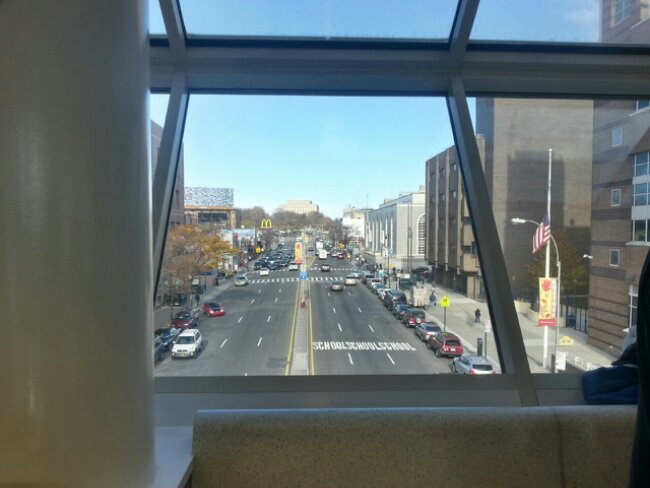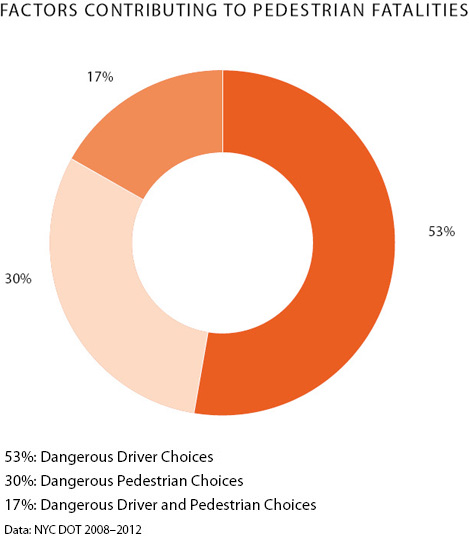
Last year there were 156 pedestrian fatalities on the streets of New York City representing an increase from 2012 as well as 2011. According to an analysis done by the Daily News of NYPD statistics, there were 7 pedestrian related deaths during the first 12 days of this year and if this trend were to continue it would put us on pace to hit well over 200 fatalities this year.
Caroline Samponaro, a senior director at Transportation Alternatives, the bicycle and pedestrian advocacy group told the Daily News, “I think the numbers aren’t getting any better, period…The rise in and of itself raises an alarm.”
With such an alarming increase of these incidents, Mayor De Blasio and his administration has launched Vision Zero Action Plan, a massive multi-prong and interdepartmental initiative to make the streets of New York City the safest of any big city in the world. This is only the beginning steps of what will be a more comprehensive plan as time progresses and the program evolves.
In the Bronx we all know too well that many of our streets are dangerous with cars exceeding speed limits as well as poorly designed crossings across major roadways like the Grand Concourse, Fordham Road, White Plains Road, and the Bruckner Boulevard.
Although DNAinfo reported that pedestrian fatalities in the Bronx dropped considerably from 28 in 2011 to 17 in 2012, (it reported no data from last year) still it is 17 too many.
Data from New York City Department of Transportation collected from 2008 through 2012 revealed the following factors related to pedestrian fatalities:
—55% were a result of dangerous driver choices.
—37% were a result of dangerous pedestrian choices.
—17% were a result of dangerous driver and pedestrian choices.

Vision Zero Action plan will establish a permanent Vision Zero task force at the Mayor’s office in City Hall. The plan will pool resourced from City Hall, NYPD, Department of Transportation, Taxi & Limousine Commission, Department of Citywide Administrative Services, Departament of Mental Health & Hygiene, and ultimately we the citizens of New York City to accomplish its goals of reducing pedestrian fatalities.
According to the newly launched Vision Zero website, the following is Vision Zero’s
Summary of Proposed City Actions:
The Vision Zero Action Plan is only a beginning for Vision Zero in New York. It defines the initial steps that the City Police (NYPD) and Transportation Departments (DOT), Taxi & Limousine Commission (TLC), the Department of Health and Mental Hygiene (DOHMH) and other agencies will take. These initiatives will be continually analyzed for their effectiveness. Other innovations will be sought and added.
City Hall
—Establish a permanent Vision Zero task force in the Mayor’s Office of Operations
—Launch a Vision Zero website to gather input from New Yorkers and coordinate information about the City’s Vision Zero plans, upcoming events and provide data
—Conduct Vision Zero presentations across the city
—Publish crash and safety data on a regular basis in user-friendly format(s)
—Partner with industry groups and vehicle manufacturers to educate fleet drivers and explore design changes to their automotive fleets
—Lead a state legislative campaign to give the City the power over the placement of speed and red-light cameras, the power to reduce the citywide speed limit to 25mph, and to increase the penalties associated with dangerous driver behavior.
Police Department
—Increase enforcement against dangerous moving violations, including speeding, failing to yield to pedestrians, signal violations, improper turns/disobeying signage, and phoning/texting while driving
—Increase speeding enforcement at the precinct level
—Purchase advanced speed detection equipment (LIDAR guns), upgrade speed detection technology available to precincts and train additional personnel
—Increase the Highway Unit to 263 personnel
—Expand Collision Investigation Squad cases to encompass all crashes with critical injuries
—Modify precinct-level traffic plans to increase focus on pedestrian safety
—Update technology for capturing crash data
—Enhance training for officers to better record and preserve crash details and site evidence
—Broaden recruiting efforts for School Crossing Guards
Police Department + Department of Transportation
—Conduct intensive street-level outreach and enforcement on safety problems and traffic laws, focused in areas with known crash histories
—Convene monthly meetings of DOT Traffic Division and NYPD Transportation Bureau to review traffic safety performance and set strategy for improvement
—Develop data-driven citywide enforcement strategy
—Develop borough-wide safety plans in close coordination with community boards, community organizations, and the Mayor’s Community Affairs Unit
—Conduct targeted outreach in 500 schools each year, educating students about protecting themselves as safe pedestrians and working with their families for safer school zones
Department of Transportation
—Implement safety engineering improvements at 50 intersections and corridors
—Create 25 new arterial slow zones
—Implement eight new neighborhood slow zones
—Install speed cameras at 20 new authorized locations
—Install 250 speed bumps, including in neighborhood slow zones
—Enhance street lighting at 1,000 intersections
—Enhance maintenance of street markings
—Install traffic signals where needed for speed control via coordinated arterial signal time
—Additional street reconstruction safety projects
—Survey national and international best practices to expand potential strategies
—Hold workshops for major street design projects
—Undertake a high-quality ad campaign aimed at reducing speeding, failure-to-yield and other forms of reckless driving
—Increase extent of “Choices” anti-DWI campaign
—Double number of programmable speed boards for intensive education/enforcement initiative
—Make effective, age-appropriate safety curriculum available to schools throughout the city
—Partner with senior centers to increase communication and get specific feedback from aging New Yorkers about street safety improvements
—Increase the number and visibility of hands-on safety demonstrations
—Add safety flyers and messaging in DOT mailings such as Alternate Side Parking regulations and construction permits
Department of Transportation + Taxi & Limousine Commission
—Issue summonses to TLC drivers identified by red light cameras (in addition to summonses currently issued to vehicle owners)
—Update taxi school to account for new streetscape features and alert drivers to higher-crash street types
Taxi & Limousine Commission
—Create TLC safety enforcement squad, equipped with speed radar equipment, to enforce speed and safety regulations
—Pilot program to place black box data recorders in TLC-licensed vehicles
—Implement more comprehensive, taxi-specific, driving curriculum for initial licensees
—Pursue requirement of additional behind-the-wheel driving instruction for drivers involved in frequent crashes, and continued driver safety education
—Pilot technology that alerts passengers and drivers that they are traveling over the speed limit
—Explore in-car technology that limits vehicle speed, warns drivers of impending collisions or that reduces the fare when the driver speeds
—Introduce street safety PSAs on Taxi TV
—Use driver information monitors to send safety reminders to taxi drivers
—Add safety flyers and messaging in TLC mailings to drivers
—Include left turn reminder stickers in TLC-licensed vehicles
—Create publicly accessible Honor Roll of safe TLC drivers
—Enhance enforcement against drivers offering for-hire service without TLC licenses
—Explore vehicle design requirements to improve safety
Department of Citywide Administrative Services
—Ensure all City fleet vehicles are equipped with technology that record speeding and other dangerous driving behaviors, by the end of 2014
—Upgrade the collision tracking system for the citywide fleet through the new NYC Fleet Focus fleet system
—Oversee a citywide expansion of Defensive Driver training courses for all employees driving City vehicles
—Recommend safety related devices and designs, such as high visibility vehicles, back-up cameras, and rear wheel side guards, for City vehicles and other vehicles under City regulation
Department of Health and Mental Hygiene
—Conduct public health surveillance on traffic-related hospitalizations and fatalities
—Provide Vision Zero task force with public health data to help target traffic safety interventions
—Include traffic fatalities and injuries and prevention messages in public health reports
—Engage community public health partners in promoting Vision Zero goals
—Promote research on walking, driving, motorcycling, and bicycling behaviors and patterns in the city
Bookmark Vision Zero’s website so you can remain up-to-date with any information they may disseminate.
Welcome2TheBronx encourages reader submissions for consideration for publication on our site. It is our mission to be able to provide a platform where Bronx residents can have their voices broadcasted to a wider audience.
To submit an article, email us at submissions@welcome2thebronx.com






